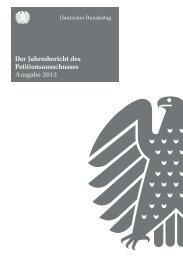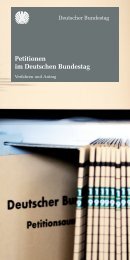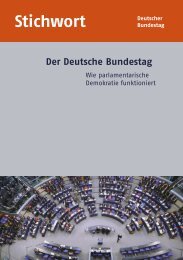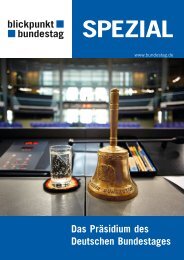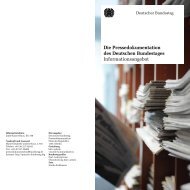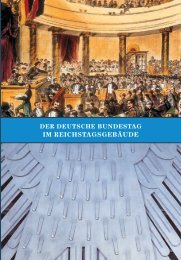Facts - The Bundestag at a glance - Deutscher Bundestag
Facts - The Bundestag at a glance - Deutscher Bundestag
Facts - The Bundestag at a glance - Deutscher Bundestag
You also want an ePaper? Increase the reach of your titles
YUMPU automatically turns print PDFs into web optimized ePapers that Google loves.
<strong>The</strong> Marie-Elisabeth Lüders Building<br />
<strong>The</strong> new <strong>Bundestag</strong> building bearing<br />
the name of Liberal politician Marie-<br />
Elisabeth Lüders serves as the parliamentary<br />
inform<strong>at</strong>ion and service centre,<br />
housing the large library, the archives,<br />
the Press Document<strong>at</strong>ion Division and<br />
the Research Services. <strong>The</strong> library in<br />
the Marie-Elisabeth Lüders Building,<br />
with more than 1.4 million volumes, is<br />
one of the largest parliamentary libraries<br />
in the world. Below the inform<strong>at</strong>ion<br />
and advice level of the library rotunda<br />
is a section of the Berlin Wall within<br />
an otherwise empty room. <strong>The</strong> piece of<br />
wh<strong>at</strong> was known as the hinterland wall<br />
follows the former course of th<strong>at</strong> wall<br />
and is a reminder of the history of the<br />
site. <strong>The</strong> building also contains a large<br />
hearing room, which is chiefly used by<br />
study commissions and committees of<br />
inquiry. <strong>The</strong> public have access to the<br />
<strong>Bundestag</strong> Art Room, where exhibitions<br />
of contemporary art with a parliamentary<br />
and political flavour are held.<br />
<strong>Bundestag</strong> buildings<br />
Marie-Elisabeth Lüders (1878–1966)<br />
Liberal politician Marie-Elisabeth<br />
Lüders is regarded as one of the most<br />
important social campaigners and one of<br />
the leading represent<strong>at</strong>ives of the women’s<br />
movement in Germany. In 1912 she<br />
became the first woman in Germany to<br />
obtain a doctor<strong>at</strong>e in political science;<br />
in the period up to 1918 she performed<br />
several leading functions in the realm of<br />
social work and in the effort to improve<br />
conditions for women. In 1919 she<br />
became a member of the constituent N<strong>at</strong>ional<br />
Assembly; from 1920 to 1921 and<br />
from 1924 to 1930 she was a member<br />
of the Reichstag. In 1933 the N<strong>at</strong>ional<br />
Socialists banned her from exercising<br />
her profession and from publishing her<br />
writings; in 1937 she had to endure four<br />
months of solitary confinement.<br />
From 1953 to 1961, she represented the<br />
FDP in the <strong>Bundestag</strong> and opened two of<br />
its constituent sittings as President by age.<br />
<strong>The</strong> Marie-Elisabeth Lüders<br />
Building, a parliamentary treasure<br />
trove of knowledge.



